Itk.fpik.ipb.ac.id
Jurnal Ilmu dan Teknologi Kelautan Tropis, Vol. 7, No. 2, Hlm. 603-612, Desember 2015
ANTIBACTERIAL ACTIVITY ASSAY OF MANGROVE EXTRACTS AGAINST
SALMONELLA TYPHI AND LISTERIA MONOCYTOGENES
UJI AKTIVITAS ANTIBAKTERI EKSTRAK MANGROVE TERHADAP SALMONELLA
TYPHI DAN LISTERIA MONOCYTOGENES
Apon Zaenal Mustopa1*, Rifqiyah Nur Umami1, dan Melki2
1Research Center for Biotechnology, Indonesian Institute of Sciences, Bogor, Indonesia
2Marine Science Department, Faculty of Natural Science, Sriwijaya University, Palembang
*Email:
[email protected]
Aktivitas antibakteri ekstrak tanaman mangrove, Avicennia marina, Sonneratia caseolaris (berasal
dari Teluk Payo, Banyuasin, Sumatera Selatan), Ceriops tagal, Rizhopora apiculata, dan Sonneratia
alba (berasal dari Sadai, Bangka Selatan) terhadap Salmonella typhi dan Listeria monocytogenes
diteliti menggunakan uji disk difusi agar. Ekstraksi dilakukan menggunakan solven organik (metanol,
etil asetat dan aseton secara berurutan). Sebagian besar dari ekstrak yang diuji menunjukkan potensi
aktivitas antibakteri terhadap kedua patogen. Ekstrak metanol kulit batang S. alba dan buah A.
marina menunjukkan zona hambat yang cukup besar (15 mm) terhadap S. typhi. Ekstrak aseton daun
S. alba menunjukkan zona hambat terbesar (14 mm) ketika diuji terhadap L. monocytogenes.
Purifikasi parsial lebih lanjut dari ekstrak terpilih yang menunjukkan daya hambat besar dilakukan
menggunakan kromatografi kolom gel silika dengan berbagai komposisi eluen yang memiliki
perbedaan polaritas. Fraksi ketiga dari ekstrak metanol daun S. alba yang dielusi dengan kloroform:
metanol (1:5) menghasilkan zona hambat yang besar (23 mm) terhadap S. typhi. Fraksi ketiga dan
ketujuh dari ekstrak aseton daun S. alba yang dielusi dengan etil asetat:metanol (7:3) menghasilkan
zona hambat yang besar (15 mm) terhadap L. monocytogenes. Sedangkan fraksi keenam dari ekstrak
metanol buah A. marina yang dielusi dengan kloroform:metanol (6:4) menghasilkan zona hambat
terbesar (17 mm) terhadap L. monocytogenes. Hasil ini mengindikasikan bahwa ekstrak mangrove
dapat dikembangkan menjadi biomaterial untuk industri biofarmasi maupun biopreservasi.
Kata kunci: aktivitas antibakteri, mangrove, kromatografi kolom
ABSTRACT
The antibacterial activities of mangrove species,
Avicennia marina,
Sonneratia caseolaris (collected
from Teluk Payo, Banyuasin, South Sumatera),
Ceriops tagal,
Rizhopora apiculata, and
Sonneratia
alba (collected from Sadai, South Bangka) were screened against
Salmonella typhi and
Listeria
monocytogenes by agar disk diffusion assays. Extractions were conducted using organic solvents
(methanol, ethyl acetate, and acetone, subsequently). Most of the extracts tested showed potential
antibacterial activity against both pathogens. The methanol extracts of the bark from
S. alba and the
fruit from
A. marina showed particularly large inhibition zones (15 mm) against
S. typhi. The acetone
extract of
S. alba leaves showed the largest inhibition zone (14 mm) when tested against
L. Monocy-
togenes. Further partial purifications of selected extracts which showed strong inhibition were
performed by silica gel column chromatography using various eluent compositions with different
polarities. The third fraction of methanol extract from
S.alba leaves eluted with chloroform:methanol
(1:5) resulted in a remarkably large inhibition zone (23 mm) against
S. typhi. The third and seventh
fractions of acetone extract from
S. alba leaves eluted with ethyl acetate:methanol (7:3) resulted in a
large inhibition zones (15 mm) against
L. monocytogenes. In addition, the sixth fraction of methanol
extract from
A. marina fruit eluted with chloroform : methanol (6:4) resulted in the largest inhibition
zone (17 mm) against
L. monocytogenes. These results indicated that mangrove extracts could be
developed as potential biomaterials for biopharmaceutical as well as biopreservation industries.
Keywords: antibacterial activity, mangrove, column chromatography
@Ikatan Sarjana Oseanologi Indonesia dan
Departemen Ilmu dan Teknologi Kelautan, FPIK-IPB
Antibacterial Activity Assay . .
I. INTRODUCTION
derived from mangrove extracts. The current
study aims to explore the potentials of some
Health problems caused by bacterial
selected mangrove species collected from
pathogens derived from food spoilage re-
Indonesian mangrove forests, with emphasiz-
mains to be a risk factor particularly in
ed to screen their antibacterial activities aga-
developing countries which have sanitation
inst two representative foodborne pathogens-
issues. Antibiotics and chemicals are com-
Salmonella typhi and
Listeria monocy-
monly used as therapeutic medicines against
bacterial infections. However, maltreatments
S. typhi is a Gram-negative bacterium
of antibiotics and chemotherapeutic agents
that belongs to the family
Enterobacteri-
are heading to the new problem of drugs
aceae.
S. typhi infection could lead to the
resistance. Thus, the discovery of new and
development of typhoid or enteric fever and
safe antibacterial compounds is continuously
remains as a threat for public health. Some
needed to work against resistant pathogens.
risk factors such as the oversuse, misuse and
The widespread use of plants for
inappropriate antibiotics prescribing could be
medication is already known for a long
responsible for the increasing number of
period of time. Plant extracts and phyto-
multi-drug resistance problem among
S. typhi
chemicals have the potentials as alternative
strains, including ineffective or sub-optimal
treatments against bacterial infections. Indo-
therapy using ampicillin, chloramphenicol,
nesia has been blessed with enormous tropi-
trimethoprim-sulphamethoxazole, and fluoro-
al plant species that may represent a source
quinolones such as ciprofloxacin, and oflo-
of natural medicines. An interesting group of
xacin (Zaki and Karande, 2011; Butler,
plants in this regard are mangroves.
According to Kusmana (2014), there are
L. monocytogenes is a Gram-positive
approximately 3.2 million hectares of mang-
bacterium.
L. monocytogenes is a causative
rove area in Indonesia with over 202 mang-
agent of listeriosis, however, unlike any other
rove species. However, natural medicines
foodborne pathogens, it has the ability to
derived from mangroves are still inadequa-
survive food-processing technologies, and
tely studied due to their limited distribution.
could grow even in properly refrigerated
Mangroves are typical plants that live
food. People usually get infected through the
in littoral zone with harsh environmental
consumption of contaminated food. Although
conditions such as anaerobic soils, wide
it is a relatively rare infection,
L. Monocyto-
range of saline concentrations, tidal waves,
genes is one of the most virulent foodborne
winds and extreme temperatures. Mangrove
pathogens since it could lead to severe infec-
plants often produce diverse groups of
tion with up to 30% fatality rates even with
unique chemical components as secondary
early and adequate antibiotics treatment. The
metabolites for protection and adaptation in
most common clinical manifestation of
such challenging conditions. Those com-
listeriosis is meningitis, and usually being
pounds often have interesting antibacterial,
treated with ampicillin, penicillin or a combi-
antiviral and antifungal activities. Neverthe-
nation of ampicillin and gentamycin. Other
less, there are only limited investigations that
options are trimethoprim-sulfamethoxazole,
have been conducted to identify the metabo-
erythromycin, vancomycin, fluoroquinolones
lite agents, which might be responsible for
(ciprofloxacin) and quinolones (levofloxacin
their bioactivities (Bandaranayake, 2002;
and moxifloxacin). Some
L. monocytogenes
Eldeen and Effendy, 2013).
isolates were reported to have low resistance
In vitro screening for antibacterial
to these antibiotics (Allerberger and Wagner,
activity could be one of the initial steps for
2010; Hernandez-Milian and Payeras-Cifre,
the discovery of new antimicrobial agents
Mustopa
et al.
II. METHODS
longer the contact between solvents and
materials the more the bioactive compounds
2.1. Mangrove Plants Collection
will be extracted. Furthermore, the selected
The mangrove plants,
Avicennia
solvents should be less toxic and should not
marina (Forsk.) Vierh., and
Sonneratia
influence the antibacterial assay results
caseolaris (L.) Engl., were collected from
(Ncube
et al., 2008). Based on the fact that
Teluk Payo, Banyuasin, South Sumatera,
most of the identified bioactive compounds
Indonesia. The locations extend from
which possess antibacterial activity are com-
02°26'08.6" to 02°26'12.45"S and 104°45' monly less polar or not water soluble, org-52" to 104°45'59.9"E. While
Ceriops tagal anic solvents (methanol, ethyl acetate and (Perr.) C. B. Rob.,
Rizhopora apiculata Bl.,
aceton) were used in this study.
and
Sonneratia alba J.E. Smith, were
The powdered samples were extracted
collected from Sadai, South Bangka, Indo-
with a series of organic solvents at room tem-
nesia, with sampling locations extend from
perature according to the standard methods
03°00'02.1" to 03°00'15.2"S and 106°43'45. (Joel and Bhimba, 2010; Sahoo
et al., 2012) 2" to 106°43'43.2"E. Information about the with some modifications. Briefly, to prepare environmental conditions including salinity,
methanol extracts, 100 g of powdered
temperature, pH and dissolve oxygen (DO)
samples were soaked into 250 mL 80% me-
of the locations were recorded. The mang-
thanol and stirred. The solvent was subtituted
rove samples were taxonomically identified
in every 24 hours for 3 days. The total
based on their morphological features at
extracts were then filtered through Whatman
Marine Science Department, Faculty of Na-
No.1 filter paper. The filtrate was concentrat-
tural Science, Sriwijaya University, South
ed using a rotary evaporator at 50°C to get
Sumatera, Indonesia.
crude methanol extracts. To prepare ethyl
acetate extracts, methanol extract residues
2.2. Mangrove Samples Extraction
were soaked into 250 mL 80% ethyl acetate
The fresh samples were washed with
and stirred. The solvent was subtituted in
water to remove dirt and then dried in the
every 24 hours for 3 days. The total extracts
oven at 60°C for 3 days for leaf samples and
were then filtered through Whatman No.1
up to 7 days for root, bark and fruit samples,
filter paper. The filtrate was concentrated
respectively. The dried samples were then
using a rotary evaporator at 40°C to get crude
crushed and powdered into fine particles.
ethyl acetate extracts. To prepare acetone
Instead of the fresh samples, the dried mang-
extracts, ethyl acetate extract residues were
rove plant materials were used since the
soaked into 250 mL 80% acetone and stirred.
differences in water content may affect the
The solvent was subtituted in every 24 hours
solubility. The dried samples were ground
for 3 days. The total extracts were then
into fine particles to increase the surface
filtered through Whatman No.1 filter paper.
areas, thus will increasing the extraction
The filtrate was concentrated using a rotary
evaporator at 40°C to get crude acetone
The extraction method aims to sepa-
extracts. The extracts were stored at 4°C in
rate the bioactive compounds of the plant
air-tight glass vials prior to
in vitro antibac-
parts from the inactive components using
terial screening.
selected solvents. The choice of the solvents
for extraction had definite effects for the
2.3. Antibacterial Activity Assay
isolation of bioactive compounds since the
Initial screening of potential anti-
solvents will diffuse into the solid plant
bacterial activity or commonly known as
materials and solubilise the biocompounds
antimicrobial susceptibility testing (AST) of
with similar polarity during extractions. The
the crude mangrove extracts was performed
Jurnal Ilmu dan Teknologi Kelautan Tropis, Vol. 7, No. 2, Desember 2015
Antibacterial Activity Assay . .
against
Salmonella typhi (P2KIM collection)
was eluted with various selected eluent
and
Listeria monocytogenes (BTCCB693) by
compotitions initially tested on thin layer
Kirby-Bauer agar disk diffusion test method
chromatography (TLC) according to the
(Bauer
et al., 1966; CLSI, 2012). The AST
method described by Harborne (1984), for
method is formerly used as an essential
optimization of the gradient polarities i.e.,
method to determine the microbial resistance
chloroform: methanol (1:5); ethyl acetate :
to antimicrobials. In this study, the AST
methanol (7:3); and chloroform : methanol
method was used as preliminary screening to
(6:4). Individual fractions were then collect-
elucidate the efficacy of antimicrobial
ed and tested for antibacterial activity scree-
candidates derived from mangrove extracts
ning by the same method as described above.
against representative microbial pathogens.
Further TLC analysis using silica gel GF254
The agar diffusion based is the conventional
(Merck) and chloroform: methanol (8:3) as
reference method, however, the bactericidal
eluent was carried out for the fraction with
and bacteriostatic effects could not be
the strongest antibacterial activity. The TLC
differentiated using this method.
results were visualized after heat treatment
Briefly, the obtained crude extracts
and under UV light 254 nm.
dissolved in the respective solvents (20 μl)
and positive controls (penicillin or chloram-
III. RESULTS AND DISCUSSIONS
phenicol) were individually applied to the
sterilized filter paper disks (Filtres Fioroni®,
3.1. Mangrove Samples Collection and
France; 6 mm in diameter) and then placed
Extraction
on nutrient agar (NA-Oxoid®, England) test
Mangrove plants are generally under-
plates inoculated with the overnight culture
valued and poorly managed. However, nume-
of pathogens which had been prepared from
rous mangrove plants had been used in
the suspension equivalent to 0.5 McFarland
folklore medicine as alternative treatment
turbidity standard (108 CFU/ml). Sterile for-
againts human and animal diseases. In this
ceps were used to assure complete contact
regard, scientific evidence of their bioacti-
between the paper disks and the surface of
vities are considerably needed. Mangroves
agar medium. The disks were arranged in a
are usually need warm condition for survival,
proper space to prevent the overlapping of
thus most of their habitats are in tropical
the inhibition zones. The whole set up was
areas. In this study, five species of mangrove
first incubated at 4°C for 2 hours to give
plants (i.e.,
A. marina, C. tagal, R. apiculata,
sufficient time for the samples to diffuse into
S. alba and
S. caseolaris) were collected
the medium. Then the test plates were kept at
from Indonesian mangrove habitats. Diffe-
37°C for 16, 20, or 24 hours to allow the
rent plant parts of the mangrove species
bacterial growth. The antibacterial activity
(roots, barks, leaves and fruits) were selected
assays were determined by measuring the
as the samples for the screening of anti-
diameter of inhibition zones formed around
bacterial activity (Figure 1). In addition, the
the paper disks.
environmental factors such as salinity, tem-
perature, pH, and dissolve oxygen that could
2.4. Partial Purification of Bioactive
affect the bioactive constituents of the sam-
Compound
ples and leading to the differences in their
Selected crude mangrove extracts
bioactivities, were recorded (Table 1).
which showed strong inhibition zone were
applied into a column chromatography pack-
3.2. Antibacterial Activity Assay
ed with silica gel (60-120 Mesh, Merck)
Food borne pathogens and drug
based on the method of Mishra and Sree
resistance microbes such as
S. typhi and
L.
(2007) with some modifications. Each extract
monocytogenes remain to be problems
606 http://itk.fpik.ipb.ac.id/ej_itkt72
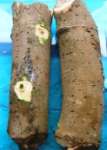
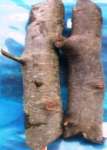
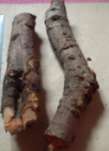
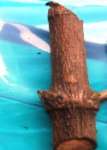
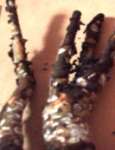
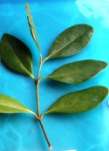
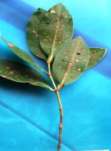
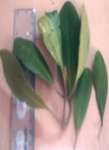
Mustopa et al.
A. marina
S. caseolaris
R. apiculata
A. marina
Figure 1. Photographs of mangrove plants collected in this study (personal collection, 1:10 in
scale). Barks and leaves (a), Fruits (b).
Table 1. Environtmental characteristics of mangrove habitat at Teluk Payo, Banyuasin, South
Sumatera and Sadai, South Bangka.
A. marina
S. caseolaris
R. apiculata
Temperature (°C)
Jurnal Ilmu dan Teknologi Kelautan Tropis, Vol. 7, No. 2, Desember 2015
Antibacterial Activity Assay . .
among food industries. In the meantime,
growth of S. aureus. The silvernanoparticles
people are questioning the safety of anti-
derived from water extract of the leaves from
biotics and chemical preservatives. In this
C. tagal exhibited antimicrobial activity
study, natural inhibitors for food borne pa-
against pathogenic bacteria and fungi (Dhas
thogens derived from the extracts of selected
et al., 2013). According to Pimpliskar et al.
mangrove plants were evaluated. This study
(2012), ethanol extract of the stem from R.
revealed that the mangrove crude extracts
apiculata showed antibacterial as well as
derived from different plant parts and eluted
antifungal activities. It is reported that etha-
with different solvents show positive anti-
nol extract of the leaves from S. alba could
bacterial activities against both of S. typhi
inhibit the growth of S. typhi (Sahoo et al.,
and L. monocytogenes.
2012), while methanol extract of the seeds
Strong inhibition activities against S.
from S. caseolaris exhibited growth inhibi-
typhi were shown by methanol extracts of the
tory effect against S. aureus (Mahadlek et al.,
bark from S. alba and the fruit from A.
2012). The methanol extract of S. caseolaris
marina (15 mm, respectively), compared to
also reported to have antibacterial activities
the positive control (10 mm), after 16 hours
against multi-drug resistants pathogens by
observations (Table 2). While acetone extract
Yompakdee et al. (2012).
of the leaves from S. alba exhibited parti-
cularly large inhibition zone against L. mono-
3.3. Partial Purification of Bioactive
cytogenes (14 mm), although it was smaller
Compound
compared to the positive control (18 mm),
Mangrove species are known as a rich
after 24 hours observations (Table 3). This
source of bioactive compounds including ste-
variable results of inhibition zones could be
roids, triterpenes, phenolics, saponins, flavo-
due to the differences of bioactive com-
noids, alkaloids and tannins (Bandara-
pounds solubility among the crude extracts.
nayake, 2002). These phytochemicals have
Previous research articles also pro-
toxicological, pharmacological and ecologi-
vide informations about the biological activi-
cal importance. A knowledge of the chemical
ties of mangrove extracts. Abeysinghe (2010)
constituents of the bioactive compounds de-
reported that some mangroves species had
rived from natural products is required since
antibacterial activities against antibiotic re-
it can be great value in discovering new
sistant Staphylococcus aureus. Dhayanithi et
sources of economic phytocompounds parti-
al. (2012) reported that methanol extract of
cularly in regard of mangrove plants. The
the leaves from A. marina could inhibit the
phytocompounds could be responsible for the
Table 2. Antibacterial activity of crude mangrove extracts against S. typhi after 16 hours
observation.
Zone of inhibition (mm)
methanol extracts
ethyl acetate extracts
acetone extracts
root bark leaf fruit root bark leaf fruit root bark leaf fruit
A. marina
R. apiculata
S. caseolaris
Note: (-) : not determined.
Positive control (penicillin) showed 10 mm of inhibition zone.
608 http://itk.fpik.ipb.ac.id/ej_itkt72
Mustopa et al.
Table 3. Antibacterial activity of crude mangrove extracts against L. monocytogenes after 24
hours observation.
Zone of inhibition (mm)
methanol extracts
ethyl acetate extracts
acetone extracts
root bark leaf fruit root bark leaf fruit root bark leaf fruit
A. marina
R. apiculata
S. caseolaris
Note: (-) : not determined.
Positive control (chloramphenicol) showed 18 mm of inhibition zone.
antibacterial activities as shown by the mang-
(Table 5 and Figure 3). While chloram-
rove extracts tested in present study. It might
phenicol as positive control showed 20 mm
be possible that each of the mangrove
of inhibition zone. In addition, thin layer
extracts contain multiple bioactive com-
chromatography (TLC) analysis of the frac-
pounds, and they inhibit bacterial growth in a
tion of S. alba which exhibited the largest
various ways. Bioactivity guided fractiona-
inhibition zone was performed as initial
tion using column chromatography was per-
detection of bioactive compound (Figure 4).
formed as an initial approach to separate the
targeting compounds from the mixture within
Table 4. Inhibition zone (mm) of column
the crude extracts (Joel and Bhimba, 2010).
fractions against S. typhi after 16
Some of the obtained fractions show-
hours observation.
ed stonger inhibition activities compared to
the crude extracts. The third fraction of
Methanol extract of
methanol extract of the leaves from S. alba
S. alba (leaves)
eluted with chloroform: methanol (1:5)
resulted in 23 mm of inhibition zone against
S. typhi after 16 hours observation (Table 4
and Figure 2). While chloramphenicol as
positive control also showed 23 mm of
inhibition zone. The third and seventh frac-
tions of acetone extract of the leaves from S.
alba eluted with ethyl acetate: methanol (7:3)
resulted in 15 mm of inhibition zones against
L. monocytogenes. The sixth fraction of me-
thanol extract of the fruit from A. Marina
eluted with chloroform: methanol (6:4)
resulted in 17 mm of inhibition zone against
Positive control
Chloramphenicol:
L. monocytogenes after 20 hours observation
Jurnal Ilmu dan Teknologi Kelautan Tropis, Vol. 7, No. 2, Desember 2015
Antibacterial Activity Assay . .
Figure 2. The arrow indicates the inhibition zone of the third fraction of methanol extract of
the leaves from S. alba eluted with chloroform : methanol (1:5) against S. typhi after 16 hours observation.
Table 5. Inhibition zone (mm) of column fractions against L. monocytogenes after 20 hours
Acetone extract of S. alba
Methanol extract of A.marina
ethyl acetate : methanol (7:3)
chloroform : methanol (6:4)
Positive control
Chloramphenicol: 20
Chloramphenicol: 20
Note: (-) : negative.
Figure 3. The arrows indicate the inhibition zone of : (a). The third and seventh fractions of acetone extract of the leaves from S. alba eluted with
ethyl acetate : methanol (7:3) against L. monocytogenes after 20 hours observation.
(b). The sixth fraction of methanol extract of the fruit from A. Marina eluted with chloroform
: methanol (6:4) against L. monocytogenes after 20 hours observation.
610 http://itk.fpik.ipb.ac.id/ej_itkt72
Mustopa et al.
Figure 4. Thin layer chromatography (TLC) analysis of the third fraction of methanol extract
of the leaves from S. alba eluted with chloroform : methanol (8:3). Detection after heat treatment (a), detection under UV light 254 nm (b).
IV. CONCLUSION
thank Muhamad Ridwan, Ika Sari Kusuma-
wati and Dwi Setianingsih for technical
The crude extracts derived from
assistance. We also thank to reviewers who
different parts of the mangrove plants with
help to improve this paper.
different solvents exhibited various level of
antibacterial activities. The results suggest
REFERENCES
that the column fractions of mangrove
extracts particularly from S. alba showed
Abeysinghe, P.D. 2010. Antibacterial activity
similar antibacterial activity compared to the
of some medical mangroves against
positive control. This promising findings
antibiotic resistant pathogenic bacte-
suggest the presence of bioactive properties
ria. Indian J. Pharm. Sci., 72(2):167-
against bacterial pathogens as the alternative
sources of antibacterial compounds. The
Allerberger, F. and M. Wagner. 2010. Lis-
mangrove plants, originated from Indonesian
teriosis: a resurgent foodborne in-
areas, have potential to be explored as valu-
fection. Clin. Microbiol. Infect., 16
able sources for pharmaceutical applications.
However, further elucidation of the com-
Bandaranayake, W.M. 2002. Bioactivities,
pounds responsible for the bioactivities inclu-
bioactive compounds and chemical
ding identification, sufficient isolation and
constituents of mangrove plants. Wetl.
purification, and also the analysis of anti-
Ecol. Manag., 10(6):421-452.
bacterial mode of action need to be perfor-
Butler, T. 2011. Treatment of typhoid fever
med for natural drug development in the
in the 21st century: promises and
Microbiol.
Infect., 17(7):959-963.
Bauer, A. W., W. M. Kirby, J. C. Sherris, and
M. Turck. 1966. Antibiotic suscepti-
This study was financially supported by
bility testing by a standardized single
BPPS DIKTI 2010 and DIPA LIPI 2011. We
Jurnal Ilmu dan Teknologi Kelautan Tropis, Vol. 7, No. 2, Desember 2015
Antibacterial Activity Assay . .
disk method. Am. J. Clin. Pathol.,
Mangrove ecosystems of Asia-status,
challenges and management strate-
CLSI. 2012. Performance standards for
gies. Springer Science & Business
antimicrobial disk susceptibility tests;
Media. New York. 37-60pp.
approved standard (11th Ed). CLSI
Mahadlek, J., T. Phachamud, and C.
document M02-A11. Wayne, PA:
Wessapun. 2012. Antimicrobial stu-
Clinical and Laboratory Standards
dies of Sonneratia caseolaris using
Institute. USA. 76p.
different agar diffusion method. Res.
Dhas, S.P., A. Mukerjhee, and N. Chandra-
J. Pharm. Biol. Chem. Sci., 3(1):404-
sekaran. 2013. Phytosynthesis of sil-
ver nanoparticles using Ceriops tagal
Mishra, P.M. and A. Sree. 2007. Anti-
and its antimicrobial potential against
bacterial activity and GCMS analysis
human pathogen. Int. J. Pharm.
of the extract of leaves of Finlaysonia
Pharm. Sci., 5(3):349-352.
obovata (a mangrove plant). Asian J.
Dhayanithi, N.B., T.T.A. Kumar, R.G.
Plant Sci., 6(1):168-172.
Murthy and K. Kathiresan. 2012. Ncube, N.S., A.J. Afolayan, and A. I. Okoh. Isolation of antibacterials from the
2008. Assessment techniques of
mangrove, Avicennia marina and
antimicrobial properties of natural
their activity against multi drug
compounds of plant origin: current
Staphylococcus
methods and future trends. Afr J.
Biotechnol., 7(12):1797-1806.
2(3):S1892-S1895.
Pimpliskar, M.R., R.N. Jadhav, and B.L.
Eldeen, I.M.S. and M.A.W. Effendy. 2013.
Jadhav. 2012. Evaluation of antimi-
Antimicrobial agents from mangrove
crobial principles of Rhizhopora spe-
plants and their endophytes. In: Vilaz,
cies along Mumbai Coast. J. Adv. Sci.
A.M. (ed.). Microbial pathogens and
Res., 3(3):30-33.
Sahoo, G., N. S. S. Mulla, Z. A. Ansari, and
science, technology and education.
C. Mohandass. 2012. Antibacterial
Formatex Research Center Spain.
activity of mangrove leaf extracts
against human pathogens. Indian J.
Harborne, J.B. 1984. Phytochemical me-
Pharm. Sci., 74(4):348-351.
thods: a guide to modern techniques
Yompakdee, C., S. Thunyaharn, and T
of plant analysis. 2nd ed. Chapman
Phaechamud. 2012. Bactericidal acti-
and Hall Ltd, New York, USA. 43p.
vity of methanol extracts of crabapple
Hernandez-Milian, A. and A. Payeras-Cifre.
mangrove tree (Sonneratia caseolaris
2014. What is new in listeriosis? Bio.
Linn.) against multi-drug resistant pa-
Med. Res. Int., 2014:358051, 7p.
thogens. Indian J. Pharm Sci. 74(3):
Joel, E.L. and V. Bhimba. 2010. Isolation
and characterization of secondary
Zaki, S.A. and S. Karande. 2011. Multi-drug
metabolites from the mangrove plant
resistant typhoid fever: a review. J.
Rhizopora mucronata. Asian Pac. J.
Infect. Dev. Ctries, 5(5):324-337.
Trop. Med., 3(8):602-604.
Kusmana, C. 2014. Distribution and current
: 17 Juni 2015
status of mangrove forests in Indo-
: 23 November 2015
nesia. In: Hanum I.F., A. Latiff, K.R.
Disetujui
: 27 Desember 2015
Hakeem, and M. Ozturk (eds.).
612 http://itk.fpik.ipb.ac.id/ej_itkt72
Source: http://www.itk.fpik.ipb.ac.id/ej_itkt72/jurnal/13_4715_ANTIBACTERIAL_ACTIVITY_ASSAY_OF_MANGROVE_EXTRACTS.pdf
FEATURE Cancer pain management Managing adult cancer pain: The latest NCCN guidelines Pain management is important for cancer patients during therapy and some-times after treatment is completed—not just at the end of life. BY CARL SHERMAN Pain is common in cancer — one-third of patients undergoing treatment and three-fourths of those with advanced
Canti del salto e della tanca CANTI DEL SALTO E DELLA TANCA LiaIl focolareIl presente MUTTOSPrimaveraCuori lontaniCuori lontaniSaluto dal CampidanoIl mietitoreIl violentoLa luna neraSposaLa portatrice d'acquaLa surbileIl banditoIl nomadeLa madreSan FrancescoGonareNovembreAprileIl falcoL'aquilaAuguraleIl cacciatoreNuoro d'invernoA VindicinoAll'amataStella L'AUTOMOBILE PASSAIl villaggioLo stazzoLa tancaLa bardanaIl poeta









